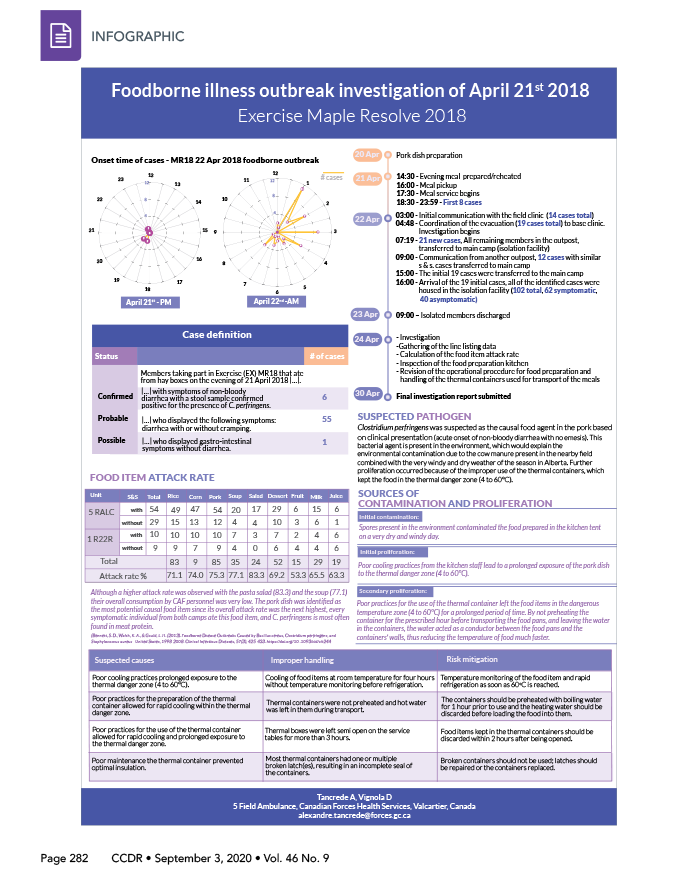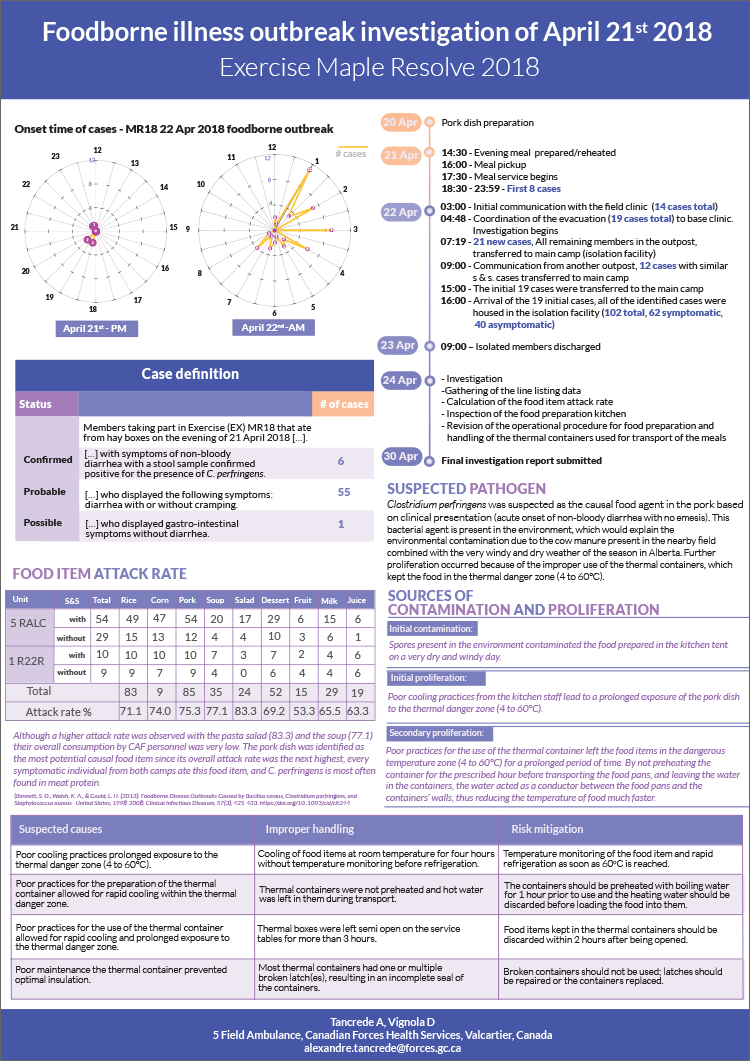Infographic: Outbreak investigation of foodborne illness 2018

 Download this article as a PDF
Download this article as a PDF
Published by: The Public Health Agency of Canada
Issue: Volume 46–9: Force Health Protection
Date published: September 3, 2020
ISSN: 1481-8531
Submit a manuscript
About CCDR
Browse
Volume 46–9, September 3, 2020: Force Health Protection
Infographic
Foodborne illness outbreak investigation of April 21st 2018 (Exercise Maple Resolve 2018)

Text description: Infographic
Foodborne illness outbreak investigation of April 21st 2018
Exercise Maple Resolve 2018
This infographic depicts the timeline of the outbreak; the case definitions; the information on the suspected pathogen; the food item attack rate; the sources of contamination and proliferation; the suspected causes; the improper handling and the risk mitigation of the foodborne illness outbreak of April 21st 2018, during Exercise Maple Resolve 2018.
Timeline of the outbreak
Pork dish preparation
21 April
14:30 - Evening meal prepared/reheated
16:00 - Meal pickup
17:30 - Meal service begins
18:30 - 23:59 - First 8 cases
22 April
03:00 - Initial communication with the field clinic (14 cases total)
04:48 - Coordination of the evacuation (19 cases total) to base clinic. Investigation begins
07:19 - 21 new cases, all remaining members in the outpost, transferred to main camp (isolation facility)
09:00 - Communication from another outpost, 12 cases with similar signs & symptoms. Cases transferred to main camp
15:00 - The initial 19 cases were transferred to the main camp
16:00 - Arrival of the 19 initial cases, all of the identified cases were housed in the isolation facility (102 total, 62 symptomatic, 40 asymptomatic)
23 April
09:00 – Isolated members discharged
24 April
- Investigation
- Gathering of the line listing data
- Calculation of the food item attack rate
- Inspection of the food preparation kitchen
- Revision of the operational procedure for food preparation and handling of the thermal containers used for transport of the meals
30 April
Final investigation report submitted
Case definition
Members taking part in Exercise (EX) MR18 that ate from hay boxes on the evening of 21 April 2018 […].
6 confirmed cases - […] with symptoms of non-bloody diarrhea with a stool sample confirmed positive for the presence of C. perfringens.
55 probable cases - […] who displayed the following symptoms: diarrhea with or without cramping.
1 possible case - […] who displayed gastro-intestinal symptoms without diarrhea.
Suspected pathogen
Clostridium perfringens was suspected as the causal food agent in the pork based on clinical presentation (acute onset of non-bloody diarrhea with no emesis). This bacterial agent is present in the environment, which would explain the environmental contamination due to the cow manure present in the nearby field combined with the very windy and dry weather of the season in Alberta. Further proliferation occurred because of the improper use of the thermal containers, which kept the food in the thermal danger zone (4 to 60°C).
Sources of contamination and proliferation
Initial contamination: Spores present in the environment contaminated the food prepared in the kitchen tent on a very dry and windy day.
Initial proliferation: Poor cooling practices from the kitchen staff lead to a prolonged exposure of the pork dish to the thermal danger zone (4 to 60°C).
Secondary proliferation: Poor practices in the use of the thermal container left the food items in the dangerous temperature zone (4 to 60°C) for a prolonged period of time. By not preheating the container for the prescribed hour before transporting the food pans, and leaving the water in the containers, the water acted as a conductor between the food pans and the containers’ walls, thus reducing the temperature of food much faster.
Food item attack rate
| Food item attack rate | |||||||||||
|---|---|---|---|---|---|---|---|---|---|---|---|
| Unit | Signs & symptoms | Total | Rice | Corn | Pork | Soup | Salad | Dessert | Fruit | Milk | Juice |
| 5 RALC | with | 54 | 49 | 47 | 54 | 20 | 17 | 29 | 6 | 15 | 6 |
| without | 29 | 15 | 13 | 12 | 4 | 4 | 10 | 3 | 6 | 1 | |
| 1 R22R | with | 10 | 10 | 10 | 10 | 7 | 3 | 7 | 2 | 4 | 6 |
| without | 9 | 9 | 7 | 9 | 4 | 0 | 6 | 4 | 4 | 6 | |
| Total | 83 | 77 | 85 | 35 | 24 | 52 | 15 | 29 | 19 | ||
| Attack rate % | 71.1 | 74.0 | 75.3 | 77.1 | 83.3 | 69.2 | 53.3 | 65.5 | 63.2 | ||
Although a higher attack rate was observed with the pasta salad (83.3) and the soup (77.1) their overall consumption by CAF personnel was very low. The pork dish was identified as the most potential causal food item since its overall attack rate was the next highest, every symptomatic individual from both camps ate this food item, and C. perfringens is most often found in meat protein.
(Bennett, S. D., Walsh, K. A., & Gould, L. H. (2013). Foodborne Disease Outbreaks Caused by Bacillus cereus, Clostridium perfringens, and Staphylococcus aureus--United States, 1998-2008. Clinical Infectious Diseases, 57(3), 425-433. https://doi.org/10 .1093/cid/cit244)
Sources of contamination and proliferation
Initial contamination: Spores present in the environment contaminated the food prepared in the kitchen tent on a very dry and windy day.
Initial proliferation: Poor cooling practices from the kitchen staff lead to a prolonged exposure of the pork dish to the thermal danger zone (4 to 60°C).
Secondary proliferation: Poor practices in the use of the thermal container left the food items in the dangerous temperature zone (4 to 60°C) for a prolonged period of time. By not preheating the container for the prescribed hour before transporting the food pans, and leaving the water in the containers, the water acted as a conductor between the food pans and the containers’ walls, thus reducing the temperature of food much faster.
Suspected causes
Poor cooling practices prolonged exposure to the thermal danger zone (4 to 60°C).
Poor practices for the preparation of the thermal container allowed for rapid cooling within the thermal danger zone.
Poor practices in the use of the thermal container allowed for rapid cooling and prolonged exposure to the thermal danger zone.
Poor maintenance the thermal container prevented optimal insulation.
Improper handling
Cooling of food items at room temperature for four hours without temperature monitoring before refrigeration.
Thermal containers were not preheated and hot water was left in them during transport.
Thermal boxes were left semi-open on the service tables for more than three hours.
Most thermal containers had one or multiple broken latch(es), resulting in an incomplete seal of the containers.
Risk mitigation
Temperature monitoring of the food item and rapid refrigeration as soon as 60°C is reached.
The containers should be preheated with boiling water for one hour prior to use and the heating water should be discarded before loading the food into them.
Food items kept in the thermal containers should be discarded within two hours after being opened.
Broken containers should not be used; latches should be repaired or the containers replaced.
Tancrede A, Vignola D.
5 Field Ambulance, Canadian Forces Health Services, Valcartier, Canada
alexandre.tancrede@forces.gc.ca
